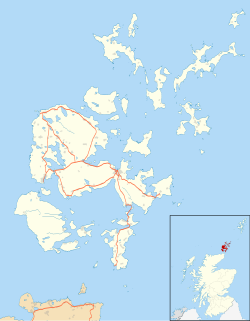Burroughston Broch
59°04′25″N 2°48′11″W / 59.073501°N 2.80297°W
 Interior of Burroughston Broch | |
| Location | Shapinsay |
|---|---|
| Coordinates | 59°04′25″N 2°48′11″W / 59.073501°N 2.80297°W |
| Type | Broch |
| History | |
| Periods | Iron Age |
| Official name | Hillock of Burroughston,broch |
| Designated | 15 December 1953 |
| Reference no. | SM1421 |
Burroughston Broch is an
Location
Burroughston Broch overlooks the
Description
The walls of Burroughston Broch have an external diameter of around 18 metres, and an internal diameter of around 10 metres.[2] From the outside, the building appears as a grassy mound, and little of the outer wall is exposed.[2]
The entrance passage is on the east side, and is about 4 metres long, 1.2 metres wide and 1.8 metres high.[2] There is an elongated guard room opening from the left side of the passage.[2] Inside the broch, the outer face of the upper gallery is still visible, and traces of an opening to the upper gallery are still apparent.[2] A deep well is present in the broch floor: the upper part being dry stone masonry, the lower being cut into the rock.[2]
In the sloping area in front of the broch entrance are traces of "out-buildings" now covered with turf.[2] A wall, ditch and rampart, which probably once encircled the broch, are still evident around the structure.[2]
Excavations
The broch was excavated around 1862 ("shortly after the discovery of
Little information is known about the finds. According to Petrie, they were mostly deer-horn fragments, many ox and sheep bones and "several rude stone vessels of different sizes", including a possible triangular lamp.[2]
See also
Bibliography
- C. Michael Hogan, California Arts and Sciences Institute casicalifornia.org (2007) Burroughston Broch Megalithic Portal https://www.megalithic.co.uk/article.php?sid=7891
- C. Michael Hogan, California Arts and Sciences Institute casicalifornia.org (2007) Hilloch of Burroughston, Broch Modern Antiquarian. https://www.themodernantiquarian.com/post/63606/images/hillock_of_burroughston.html
- Spotting History (2023) Burroughston Broch, Orkney Islands https://www.spottinghistory.com/view/4576/burroughston-broch/
References
External links
 Media related to Burroughston Broch at Wikimedia Commons
Media related to Burroughston Broch at Wikimedia Commons- Historic Environment Scotland. "Hillock of Burroughston,broch (SM1421)".

